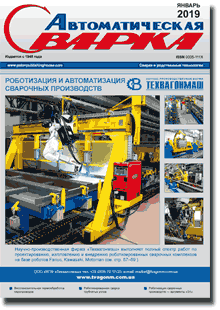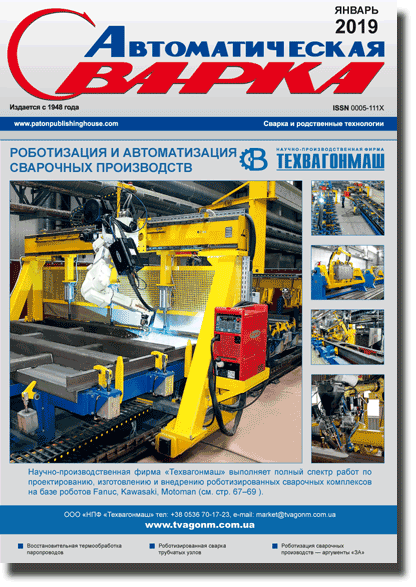| 2019 №01 (07) |
DOI of Article 10.15407/as2019.01.01 |
2019 №01 (02) |

Avtomaticheskaya Svarka (Automatic Welding), #1, 2019, pp. 11-17
On problem of contact resistance of different-sized surfaces
D.M. Kaleko
E.O. Paton Electric Welding Institute of the NAS of Ukraine, 11 Kazimir Malevich Str., 03150, Kyiv, Ukraine. E-mail: office@paton.kiev.ua
A theory of electric contacts assumes an experimentally-verified inverse proportionality of electric transient resistance from applied load. The paper shows that this condition is not fulfilled at small compression forces of different-sized contacts, which take place, in particular, in excitation of electric arc by contact or breakup of thin conductor. Measurements of electric resistance of near-contact area between thin (0.75 mm diameter) conductor and sheet of steels St37 (steel 10) and 1.4301 (08Kh18N10), brass CuZn37 (L63) and aluminum alloy AlMg3 (AMg3) showed that there is an increase of electric resistance due to elastic deformation of contact surface under effect of local loading in rise of forces to specific limits. Under experiment conditions a boundary force made 2-3 daN, depending on mechanical characteristics of metal. Out of these limits a generally accepted functional dependence becomes effective. 12 Ref., 1 Tabl., 8 Fig.
Keywords: transient electric resistance, electric contacts, elastic deformation, studs welding
Received: 26.08.2018
Published: 20.12.2018
References
1. Holm, R. (1961) Electric contacts. Moscow, IL [in Russian].
2. Kochergin, K.A. (1972) Pressure welding. Leningrad. Mashinostroenie [in Russian].
3. Sakhatsky, G.V. (1979) Technology of cold welding. Kiev, Naukova Dumka [in Russian].
4. Karakozov, E.S. (1986) Pressure welding of metals. Moscow, Mashinostroenie [in Russian].
5. Demkin, N.V., Ryzhov, E.V. (1981) Quality of surface and contact of machine parts. Moscow, Mashinostroenie [in Russian].
6. Kragelsky, I.V., Dobychin, N.M., Kombalov, V.S. (1977) Principles of calculation for friction and wear. Moscow, Mashinostroenie [in Russian].
7. Slobodyan, M.S. (2013) Analysis of procedures for evaluation of electric resistance of areas electrode-electrode and part-part before spot resistance microwelding. Svarochn. Proizvodstvo, 8, 20-24 [in Russian].
8. Leskov, G.I. (1970) Electric welding arc. Moscow, Mashinostroenie [in Russian].
9. Askeland, D.R., Fulay, P.P., Wright, W.J. (2011) The science and engineering of materials. Cengage Learning.
10. Thornton, P.H., Krause, A.R., Davies, R.G. (1996) Contact resistance in spot welding. Welding J., 12, 402-412.
11. Johnson, G.L. (1989) Mechanics of contact interaction. Moscow, Mir [in Russian].
12. Yanke, E., Emde, F., Lyosh, F. (1977) Special functions. Formulas, plots, tables. Moscow, Nauka [in Russian].
The cost of subscription/purchase order journals or individual articles
| Journal/Currency | Annual Set | 1 issue printed |
1 issue |
one article |
| TPWJ/USD | 384 $ | 32 $ | 26 $ | 13 $ |
| TPWJ/EUR | 348 € | 29 € | 24 € | 12 € |
| TPWJ/UAH | 7200 UAH | 600 UAH | 600 UAH | 280 UAH |
| AS/UAH | 1800 UAH | 300 UAH | 300 UAH | 150 UAH |
| AS/USD | 192 $ | 32 $ | 26 $ | 13 $ |
| AS/EUR | 180 € | 30 € | 25 € | 12 € |
| SEM/UAH | 1200 UAH | 300 UAH | 300 UAH | 150 UAH |
| SEM/USD | 128 $ | 32 $ | 26 $ | 13 $ |
| SEM/EUR | 120 € | 30 € | 25 € | 12 € |
| TDNK/UAH | 1200 UAH | 300 UAH | 300 UAH | 150 UAH |
| TDNK/USD | 128 $ | 32 $ | 26 $ | 13 $ |
| TDNK/EUR | 120 € | 30 € | 25 € | 15 € |
AS = «Automatic Welding» - 6 issues per year;
TPWJ = «PATON WELDING JOURNAL» - 12 issues per year;
SEM = «Electrometallurgy Today» - 4 issues per year;
TDNK = «Technical Diagnostics and Non-Destructive Testing» - 4 issues per year.





